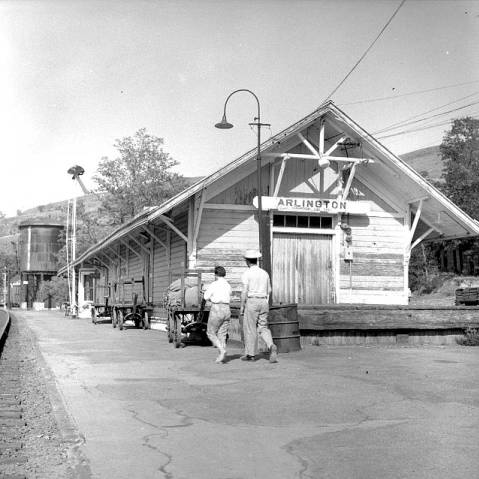On the Rail in Gilliam County
Information below is from the Gilliam County Historical Museum unless otherwise noted.
Shutler was the first railroad station on the Condon branch south of Arlington. It takes its name from the large flat area some five miles south where an old wagon with the Peter Schuttler trademark broke down and was abandoned. Through the years, the wagon disintegrated, but the maker’s sign, painted with good white lead paint, remained legible. In identifying areas, that place became known as Schuttler Flat. When Union Pacific put up the station sign, they left out the “c” and one “t”, leaving the spelling “Shutler”. Today this area is referred to as “Shutler’s Flat”.
The community of Clem was named for Clem Danneman. Clem lived in Scott?s Canyon, three or four miles southeast of the town site. His home was a stage stop between Arlington and Condon. He had a good spring there, the townsite did not. The first Clem post office was at his home. The town of Clem was started when the railroad came through in 1905. Two competing towns were platted ? Clem,laid out on the east side of the main road between Condon and Arlington, and Welshons, laid out on the west side of the road. Eventually, the towns were combined and called Clem.
In 1905 the railroad from Arlington to Condon used the MIkkalo site to refill water for the engines. The neighbors got together and voted to name the station Mikkalo after John Mikkalo who had first homesteaded in the area. The town soon began to grow with a store, hotel and post office. A blacksmith shop, several warehouses and the school were built soon after. In 1917 the Mikkalo Grange Hall was erected by two brothers who were carpenters from Portland. They had been hired to build the Cheney Place, and built several buildings in the Mikkalo area. They finished their work so quickly that the townspeople decided to commission them to build a community hall.
The railroad was completed to Condon in 1905 and the depot was built a few years later. It was located just north of Condon Grain Growers elevators. The building was moved in 1975 across Highway 19 to its present site and is now the Gilliam County Historical Museum Complex.

Arlington Railroad Depot in Gilliam County, Oregon, 1962
(ax/id/2441">Source
Arlington Railroad Depot in Gilliam County, Oregon on June 1, 1962. In the back is a water tower for the steam engines. Most of the small town of Arlington was relocated in the 1960s to make way for the John Day Dam, constructed on the Columbia River from 1958 - 1968. Five towns, l40 miles of railroad, 87 miles of roads, and many people were moved to make way for the 76 mile lake that formed behind the dam, completing the navigational thoroughfare from the Pacific Ocean to Lewiston, Idaho. About 90 percent of Arlington's business area and approximately 25 percent of its residential area was displaced by the dam project. The business district was relocated as close as practical to its original site. The town site was platted and its first post office established in 1881 at the mouth of China Creek in the Alkali Canyon. At the community's request, the legislature changed the town's name from Alkali to Arlington on December 31, 1885. It is commonly believed the name was chosen by southern settlers in honor of the home of General Robert E. Lee. However, it is likely the town was named for Nathan Arlington Cornish the resident who originally suggested the name change. Arlington's estimated population was 492 in 2003
If you have materials like family bios, photos or other documents, to donate, or would be willing to do lookups, please contact me.
DISCLAIMER:
No claim is made to the copyrights of the individual submitters. The contents of this website may be used for personal use only by individuals researching their own ancestry. Commercial use of this information for profit is strictly prohibited without prior permission of the owners. Other genealogical websites may link to this website; however, permission is not granted to duplicate any of the contents. Anyone contributing material for posting does so in recognition of its free, non-commercial distribution, as well as the responsibility to assure that no copyright is violated by the submission. This website and its coordinator are not responsible for donations of copyrighted material where explicit written permission has not been granted for use. If in doubt about the copyright rules, please refer to Understanding Copyright
Links to web sites that are not part of the USGenWeb Project are provided for your convenience and do not imply any endorsement of the web sites or their contents by The USGenWeb Project